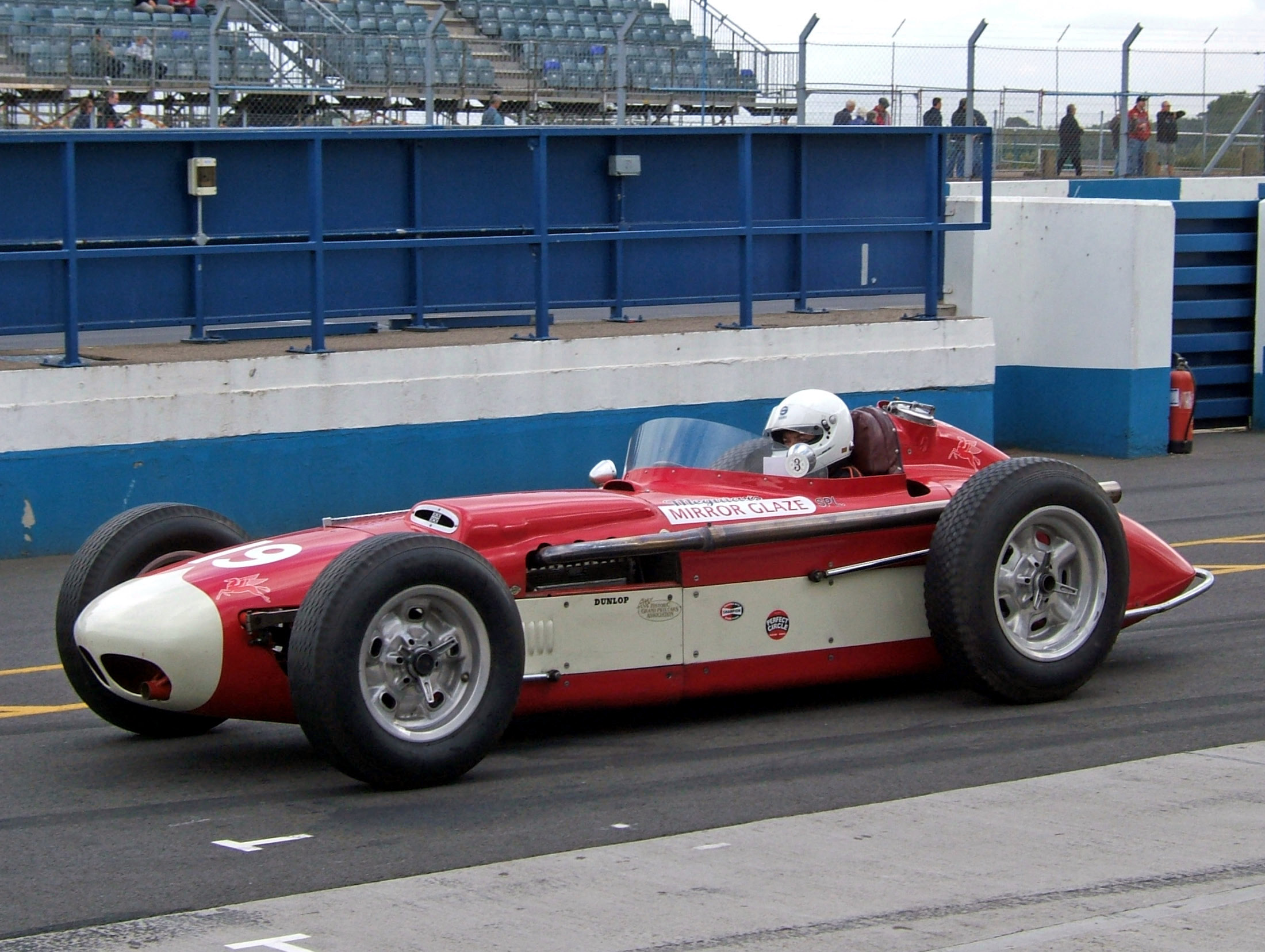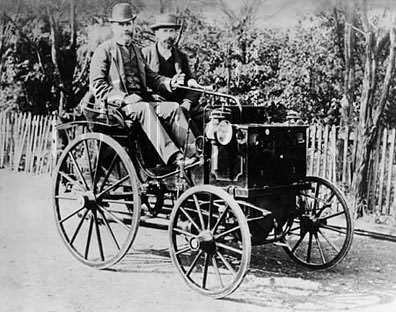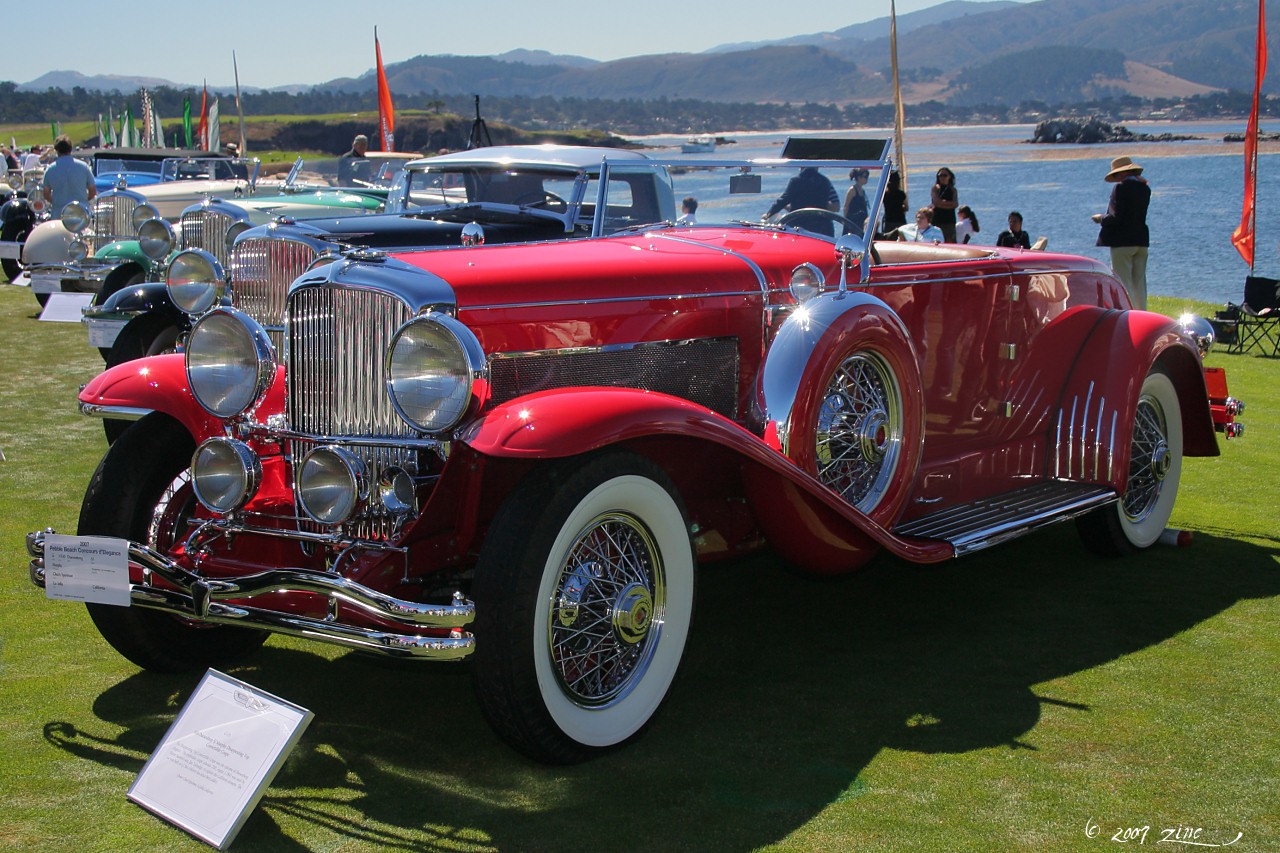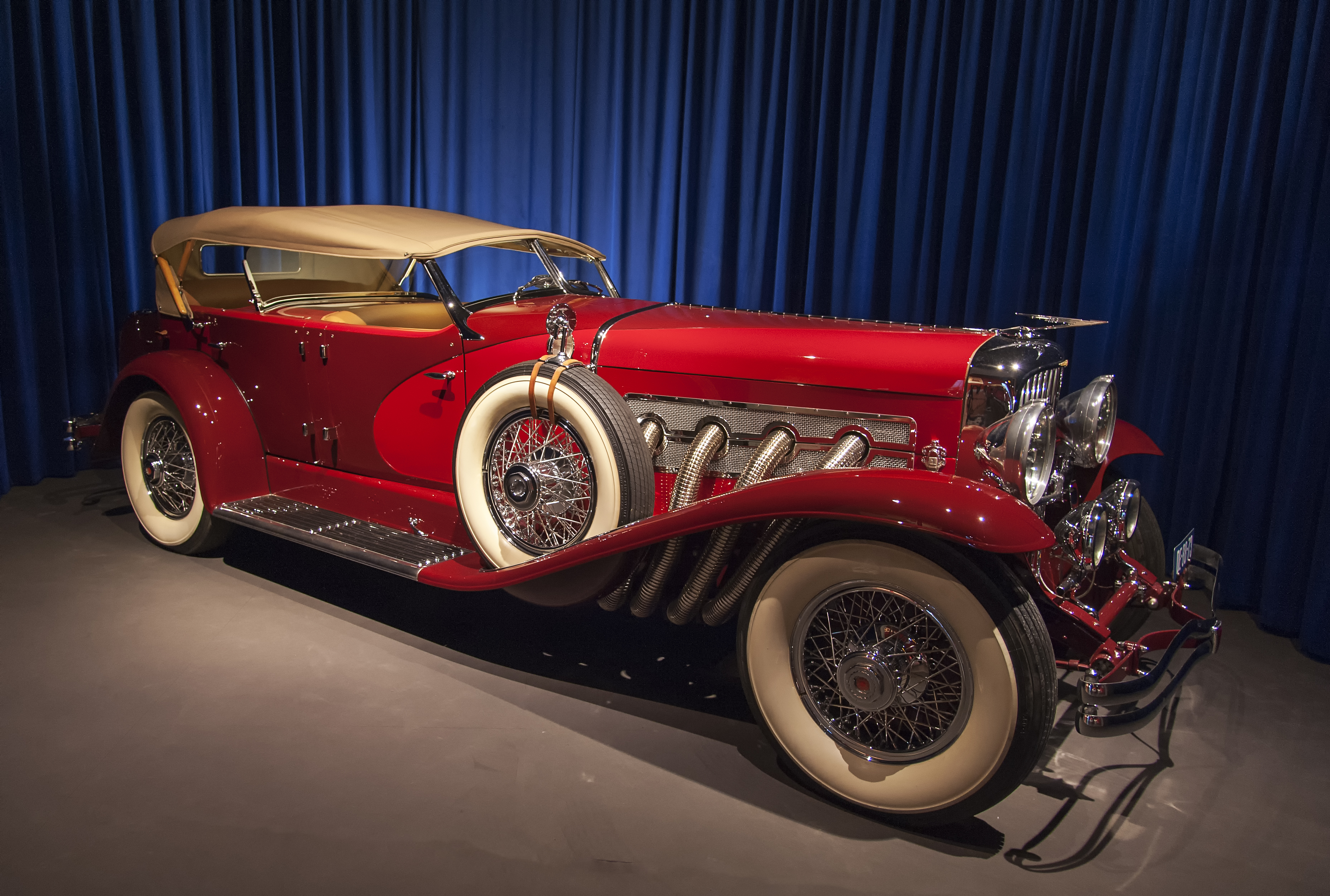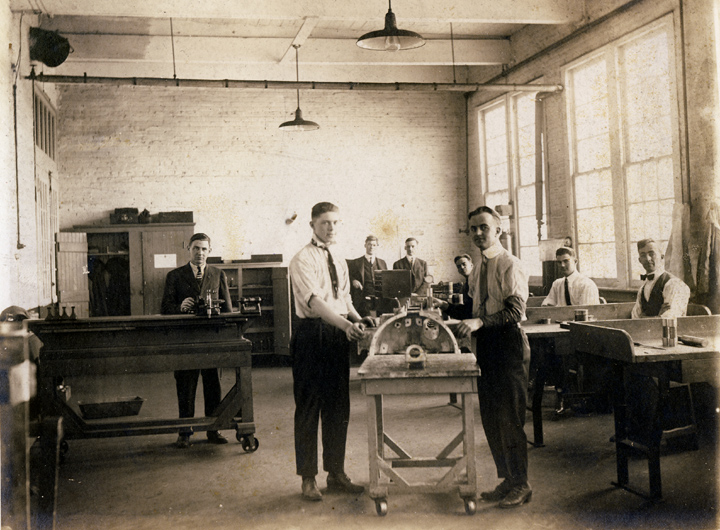|
Roadster (car)
A roadster (also spider, spyder) is an open two-seat car with emphasis on sporting appearance or character. Initially an American term for a two-seat car with no weather protection, its usage has spread internationally and has evolved to include two-seat convertibles. The roadster was also a style of racing car driven in United States Auto Club (USAC) Championship Racing, including the Indianapolis 500, in the 1950s and 1960s. This type of racing car was superseded by rear-mid-engine cars. Etymology The term "roadster" originates in the United States, where it was used in the 19th century to describe a horse suitable for travelling. By the end of the century, the definition had expanded to include bicycles and tricycles. In 1916, the United States Society of Automobile Engineers defined a roadster as: "an open car seating two or three. It may have additional seats on running boards or in rear deck." Since it has a single row of seats, the main seat for the driver and passen ... [...More Info...] [...Related Items...] OR: [Wikipedia] [Google] [Baidu] |
Mazda MX-5
The Mazda MX-5 is a lightweight two-person sports car manufactured and marketed by Mazda. The convertible is marketed as the or in Japan, and as the Mazda Miata () in the United States, and formerly in Canada, where it is now marketed as the MX-5 but is still commonly referred to as "Miata". Manufactured at Mazda's Hiroshima (Mazda factory), Hiroshima plant, the MX-5 debuted in 1989 at the Chicago Auto Show and was created under the design credo , meaning "oneness of horse and rider". Noted for its small, light, balanced and minimalist design, the MX-5 has been called a successor to 1950s and 1960s Italian and British roadster sports cars. The Lotus Elan was used as a design benchmark. Each generation is designated by a two-letter code beginning with the first generation Mazda MX-5 (NA), NA. The second generation (Mazda MX-5 (NB), NB) launched in 1998 for model year, MY 1999, followed by the third generation (Mazda MX-5 (NC), NC) in 2005 for MY 2006, and the fourth generation ... [...More Info...] [...Related Items...] OR: [Wikipedia] [Google] [Baidu] |
Paris–Rouen (motor Race)
Paris–Rouen, ''Le Petit Journal'' Horseless Carriages Contest (''Concours du 'Petit Journal' Les Voitures sans Chevaux''), was a pioneering city-to-city Auto racing, motoring competition in 1894 which is sometimes described as the world's first competitive motor race. The contest was organised by the newspaper ''Le Petit Journal (newspaper), Le Petit Journal'' and ran from Paris to Rouen in France on 22 July 1894. It was preceded by four days of vehicle exhibition and qualifying events that created great crowds and excitement. The eight qualifying events started near the Bois de Boulogne and comprised interwoven routes around Paris to select the entrants for the main event. The first driver across the finishing line at Rouen was Jules-Albert de Dion, but he did not win the main prize because his steam vehicle needed a Fireman (steam engine), stoker and was thus ineligible. The fastest petrol-powered car was a Peugeot driven by Albert Lemaître. The premier prize, the 5,0 ... [...More Info...] [...Related Items...] OR: [Wikipedia] [Google] [Baidu] |
MG TC
The MG T-Type is a series of body-on-frame open two-seater sports cars that were produced by MG Cars, MG from 1936 to 1955. Known as the Midget, the series included the TA, TB, TC, TD, and TF models. Although the design was contemporary in the 1930s, it had grown outdated by the 1950s, and was replaced by the all new MG MGA, MGA in 1955. The TF name was reinstated in 2002 on the MR layout, mid-engined MG F / MG TF, MG TF sports car. TA Midget The TA Midget replaced the MG P-type, PB in 1936. It was an evolution of the previous car and was wider in its track at and longer in its wheelbase at . The previous advanced overhead-cam inline-four engine was by then not in use by any other production car so it was replaced by the MPJG Overhead valve, OHV unit from the Wolseley Ten, but with twin SU carburetor, SU carburettors, modified camshaft and manifolding. The engine displaced just 1292 cc, with a stroke of and a bore of and power output was 50 hp (40.3 kW ... [...More Info...] [...Related Items...] OR: [Wikipedia] [Google] [Baidu] |
Delahaye 135
The Delahaye 135 is a luxury car manufactured by French automaker Delahaye. Designed by engineer Jean François, it was produced from 1935 until 1954 in many different body styles. A sporting tourer, it was also popular for racing. History The Delahaye 135, also known as "''Coupe des Alpes''" after its success in the Alpine Rally, was first presented in 1935 and signified Delahaye's decision to build sportier cars than before. The 3.2-litre overhead valve straight-six with four-bearing crankshaft was derived from one of Delahaye's truck engines and was also used in the more sedate, longer wheelbase () Delahaye 138. Power was in twin carburetor form, but were available in a version with three downdraught Solex carbs, offering a top speed. The 138 had a single carburetor and , and was available in a sportier iteration. The 135 featured independent, leaf-sprung front suspension, a live rear axle, and cable operated Bendix brakes. 17-inch spoked wheels were also standard. Tra ... [...More Info...] [...Related Items...] OR: [Wikipedia] [Google] [Baidu] |
Duesenberg J
The Duesenberg Model J was a Luxury vehicle, luxury automobile made by Duesenberg exclusively in 1928 and offered for ten subsequent years. Intended to compete with the most luxurious and powerful cars in the world, it was introduced in 1928, the year before the stock market crash that led to the Great Depression. Duesenberg Motors Company went bankrupt in 1937. Background Errett Lobban Cord, E. L. Cord, the owner of Auburn Automobile Company, and other transportation firms, bought the Duesenberg Motor Corporation on October 26, 1926, for the brothers' engineering skills, talent and brand name. He intended to produce a car to rival the size, power, and luxury of top European brands such as Hispano-Suiza and Rolls-Royce Limited, Rolls-Royce. After Cord's takeover, the new company was renamed "Duesenberg, Inc." Fred Duesenberg would continue in the new organization with the title of vice president in charge of engineering and experimental work. Fred's brother August, who had played ... [...More Info...] [...Related Items...] OR: [Wikipedia] [Google] [Baidu] |
Bugatti Royale
The Bugatti Type 41, better known as the Royale, is a large luxury car, ultra-luxury car built by Bugatti from 1927 to 1933, With a 4.3 m (169.3 in) wheelbase and 6.4 m (21 ft) overall length, it weighs approximately 3,175 kg (7,000 lb) and uses a 12.763 litre (778 cu in) straight-eight engine. For comparison, against the Rolls-Royce Phantom VII (produced from 2003 to 2017), the Royale is about 20% longer, and more than 25% heavier. This makes the Royale List of automotive superlatives, one of the largest cars in the world. With a production run of just seven vehicles, it is both one of the rarest and most expensive. Ettore Bugatti planned to build twenty-five of these cars and sell them to royalty as the most luxurious car ever, but the Great Depression undermined his effort: only three of the seven made were sold; six still exist, with one wrecked in a crash. Unused engines were installed in newly constructed high-speed railcars for th ... [...More Info...] [...Related Items...] OR: [Wikipedia] [Google] [Baidu] |
Duesenberg Model J
The Duesenberg Model J was a luxury automobile made by Duesenberg exclusively in 1928 and offered for ten subsequent years. Intended to compete with the most luxurious and powerful cars in the world, it was introduced in 1928, the year before the stock market crash that led to the Great Depression. Duesenberg Motors Company went bankrupt in 1937. Background E. L. Cord, the owner of Auburn Automobile Company, and other transportation firms, bought the Duesenberg Motor Corporation on October 26, 1926, for the brothers' engineering skills, talent and brand name. He intended to produce a car to rival the size, power, and luxury of top European brands such as Hispano-Suiza and Rolls-Royce. After Cord's takeover, the new company was renamed "Duesenberg, Inc." Fred Duesenberg would continue in the new organization with the title of vice president in charge of engineering and experimental work. Fred's brother August, who had played an important role in the development of the Model A an ... [...More Info...] [...Related Items...] OR: [Wikipedia] [Google] [Baidu] |
Cadillac V-16
The Cadillac V-16 (also known as the Cadillac Sixteen) was Cadillac's top-of-the-line model from its January 1930 launch until 1940. The V16 powered car was a first in the United States, both extremely expensive and exclusive, with every chassis being custom-finished to order. Only 4,076 were constructed in its 11-year run, with the majority built in its debut year before the Great Depression took strong hold. The onset of World War II reduced the sales, resulting in its demise. It was, however, at least three times cheaper than Bugatti Royale (only 6 made). Genesis In 1926, Cadillac began the development of a new, "multi-cylinder" car. A customer requirement was seen for a car powered by an engine simultaneously more powerful and smoother than any other available. Development proceeded in great secrecy over the next few years; a number of prototype cars were built and tested as the new engine was developed, while at the same time Cadillac chief Larry Fisher and GM's stylist ... [...More Info...] [...Related Items...] OR: [Wikipedia] [Google] [Baidu] |
Austin 7
The Austin 7 is an economy car that was produced from 1922 until 1939 in the United Kingdom by Austin. It was nicknamed the "Baby Austin" and was at that time one of the most popular cars produced for the British market and sold well abroad. Its effect on the British market was similar to that of the Model T Ford in the US, replacing most other British economy cars and cyclecars of the early 1920s. It was also licensed and copied by companies all over the world. The first BMW car, the BMW Dixi, was a licensed Austin 7. In France they were made and sold as Rosengarts, and in the United States they were built by the American Austin Car Company. In Japan, Nissan also used the 7 design as the basis for their first cars, although not under licence. This eventually led to a 1952 agreement for Nissan to build and sell Austins (which were now being made under the British Motor Corporation) in Japan under the Austin name. Many Austin 7s were rebuilt as "specials" after the S ... [...More Info...] [...Related Items...] OR: [Wikipedia] [Google] [Baidu] |
Ford Model T
The Ford Model T is an automobile that was produced by the Ford Motor Company from October 1, 1908, to May 26, 1927. It is generally regarded as the first mass-affordable automobile, which made car travel available to middle-class Americans. The relatively low price was partly the result of Ford's efficient fabrication, including assembly line production instead of individual handcrafting. The savings from mass production allowed the price to decline from $780 in 1910 () to $290 in 1924 ($ in dollars). It was mainly designed by three engineers, Joseph A. Galamb (the main engineer), Eugene Farkas, and Childe Harold Wills. The Model T was colloquially known as the "Tin Lizzie". The Ford Model T was named the most influential car of the 20th century in the 1999 Car of the Century competition, ahead of the Mini, BMC Mini, Citroën DS, and Volkswagen Beetle. Ford's Model T was successful not only because it provided inexpensive transportation on a massive scale, but also becaus ... [...More Info...] [...Related Items...] OR: [Wikipedia] [Google] [Baidu] |
Runabout (car)
A runabout is a car body style popular in the 1910s, based on the horse-drawn Runabout (carriage), runabout carriage. It was popular in North America from 1900 to about 1915. It was a light, basic style with no windshield, top, or doors and a single row of seats. Runabouts eventually became indistinguishable from Roadster (automobile), roadsters and the term fell out of use in the United States. The approach has evolved into the modern "city car". Origin Runabouts originated as a type of Horse and buggy, horse and carriage body. In 1881, Rufus Meade Stivers produced runabout bodies using a patent held by Joseph Tilton. Stivers, a blacksmith and wheelwright, produced the runabouts in his carriage manufactory on East 31st Street, Manhattan, established in 1851. According to ''The Carriage Journal'',The special feature of the runabout was that the body was hung low by using Crank (mechanism)#Crank axle, cranked axles, and the side-bars were attached to legs at the top of the cr ... [...More Info...] [...Related Items...] OR: [Wikipedia] [Google] [Baidu] |
Mercer (automobile)
Mercer was an United States of America, American automobile manufacturer from 1909 until 1925. It was notable for its high-performance cars, especially the Type 35 Raceabout. History The Mercer Automobile Company was formed in May 1909 in Trenton, New Jersey, Trenton, Mercer County, New Jersey, Mercer County, New Jersey. It evolved from the Walter (automobile), Walter Automobile Company, which had built the Walter (automobile), Walter and Roebling-Planche automobiles. Washington A. Roebling II arranged with William Walter, to take over his automobile company and use a vacant brewery in Hamilton, New Jersey, owned by the Kuser family. Ferdinand Roebling, son of John A. Roebling, was the president, and his nephew Washington became general manager. The secretary-treasurer was John L. Kuser. The first Mercer cars arrived in 1910. A.R. Kingston, E.T. George and C.G. Roebling were credited with the design. The Mercer was available as a Speedster (automobile), speedster, Tonneau, t ... [...More Info...] [...Related Items...] OR: [Wikipedia] [Google] [Baidu] |
